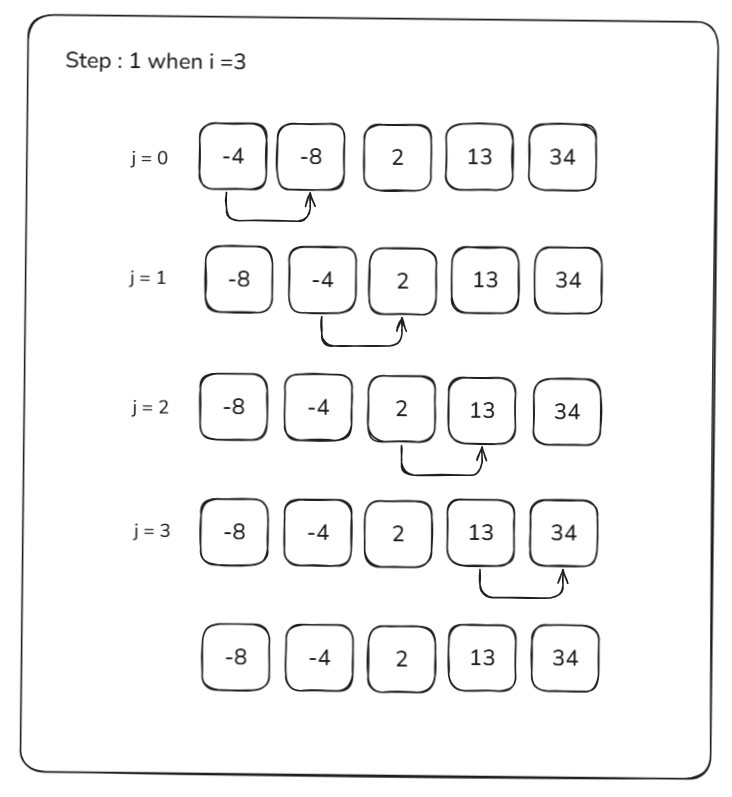Bubble Sort
 Nitin soni
Nitin soni
Bubble Sort is a simple sorting algorithm that works by repeatedly comparing two adjacent elements in an array and swapping them if they are in the wrong order.
Just like bubbles rise to the top in water, in Bubble Sort the biggest numbers slowly move to the end of the list with each round. That’s why it’s called Bubble Sort.
Working of Bubble Sort
Suppose we are trying to sort the elements in ascending order.
1. First Iteration (Compare and Swap)
Starting from the first index, compare the first and the second elements.
If the first element is greater than the second element, they are swapped.
Now, compare the second and the third elements. Swap them if they are not in order.
The above process goes on until the last element.
2. Remaining Iteration
The same process goes on for the remaining iterations.
After each iteration, the largest element among the unsorted elements is placed at the end.
In each iteration, the comparison takes place up to the last unsorted element.

The array is sorted when all the unsorted elements are placed at their correct positions.
Bubble Sort Algorithm
bubbleSort(array)
for i <- 1 to sizeOfArray - 1
for j <- 1 to sizeOfArray - 1 - i
if leftElement > rightElement
swap leftElement and rightElement
end bubbleSort
Bubble sort code :
function bubbleSort(arr) {
for (let i = 0; i < arr.length; i++) {
for (let j = 0; j < arr.length - i - 1; j++) {
if (arr[j] > arr[j + 1]) {
[arr[j], arr[j + 1]] = [arr[j + 1], arr[j]];
}
}
}
return arr;
}
console.log(bubbleSort([-4, 34, 2, 13, -8]));
In the above algorithm, all the comparisons are made even if the array is already sorted.
This increases the execution time.
To solve this, we can introduce an extra variable swapped. The value of swapped is set true if there occurs swapping of elements. Otherwise, it is set false.
After an iteration, if there is no swapping, the value of swapped will be false. This means elements are already sorted and there is no need to perform further iterations.
This will reduce the execution time and helps to optimize the bubble sort.
Algorithm for optimized bubble sort is
bubbleSort(array)
for i <- 1 to sizeOfArray - 1
swapped <- false
for j <- 1 to sizeOfArray - 1 - i
if leftElement > rightElement
swap leftElement and rightElement
swapped <- true
if swapped == false
break
end bubbleSort
Optimized bubble sort code :
function optimizedBubbleSort(arr) {
for (let i = 0; i < arr.length; i++) {
let swapped = false;
for (let j = 0; j < arr.length - i - 1; j++) {
if (arr[j] > arr[j + 1]) {
[arr[j], arr[j + 1]] = [arr[j + 1], arr[j]];
swapped = true;
}
}
if (!swapped) break;
}
return arr;
}
console.log(optimizedBubbleSort([-4, 34, 2, 13, -8]));
Bubble Sort Complexity
| Time Complexity | |
| Best | O(n) |
| Worst | O(n²) |
| Average | O(n²) |
| Space Complexity | O(1) |
| Stability | Yes |
Complexity in Detail
Bubble Sort compares the adjacent elements.
| Cycle | Number of Comparisons |
| 1st | (n-1) |
| 2nd | (n-2) |
| 3rd | (n-3) |
| ...... | ...... |
| last | 1 |
Hence, the number of comparisons is nearly equals to n2
(n-1) + (n-2) + (n-3) +.....+ 1 = n(n-1)/2
Hence, Complexity: O(n2)
Also, if we observe the code, bubble sort requires two loops. Hence, the complexity is n*n = n2
1. Time Complexities
Worst Case Complexity: O(n2) If we want to sort in ascending order and the array is in descending order then the worst case occurs.
Best Case Complexity: O(n) If the array is already sorted, then there is no need for sorting.
Average Case Complexity: O(n2) It occurs when the elements of the array are in jumbled order (neither ascending nor descending).
2. Space Complexity
Space complexity is O(1) because an extra variable is used for swapping.
In the optimized bubble sort algorithm, two extra variables are used. Hence, the space complexity will be O(2).
Bubble Sort Applications
1. Teaching and Learning: Bubble Sort is widely used to teach sorting algorithms and programming logic to beginners. It’s easy to understand and implement.
2. Small Data Sets (Games or Visualizations): Used in animations or sorting visualizers to show how sorting works step-by-step. Great for game leaderboards or quick local sorting.
3. Detecting Small Errors: If a list is almost sorted, Bubble Sort can quickly correct minor mistakes with just a few passes.
4. Embedded Systems / Microcontrollers: In low-memory environments, where simplicity is more important than speed, Bubble Sort might be used.
5. Sorting in GUI applications (like drag-and-drop): Bubble Sort can be used in simple GUI apps for live sorting small items (e.g., drag-and-drop sortable lists).
Subscribe to my newsletter
Read articles from Nitin soni directly inside your inbox. Subscribe to the newsletter, and don't miss out.
Written by

Nitin soni
Nitin soni
Full stack developer


